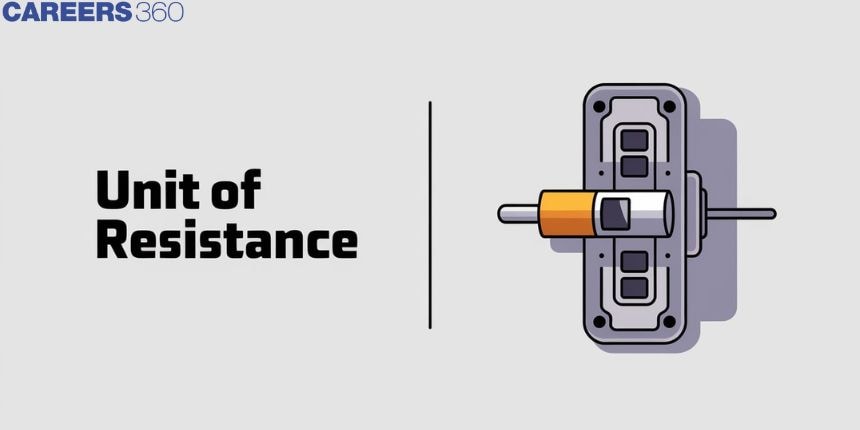Unit of Resistance
When studying electric currents, students frequently come across the term "resistance." While there are two elements that affect electric current, conductance and resistance, we will focus on the latter on this page. When it comes to resistance, it's simply described as the impediment that a substance creates in the flow of electric current and it is denoted by the letter R. We'll look at the resistance unit and other details further down. The unit of resistance is the ohm.
JEE Main 2025: Physics Formula | Study Materials | High Scoring Topics | Preparation Guide
JEE Main 2025: Syllabus | Sample Papers | Mock Tests | PYQs | Study Plan 100 Days
NEET 2025: Syllabus | High Scoring Topics | PYQs

What is the unit of resistance?
SI unit of resistance in physics or unit of resistance in physics:
The ohm, which is defined as a volt per ampere, is the si unit of resistance. In honour of German physicist George Simon Ohm, the name has been preserved. The unit is sometimes written as a word or represented by the Greek letter omega in uppercase.
Also read -
- NCERT Solutions for Class 11 Physics
- NCERT Solutions for Class 12 Physics
- NCERT Solutions for All Subjects
Specific resistance-
A conductor's resistance R is dependent on its length L, cross-section A, and composition. The resistance is proportional to the length of the conductor for a certain cross-section. Whereas the resistance of the cross-section for a certain length is inversely proportional. The two dependencies can be combined as,
R ∞ L/A
R = p L/A
Here constant proportionality is known as the specific resistance. The strength of a homogenous chunk of a unit-length and cross-sectional material is defined as the strength or resistance of a material. Quantitatively,
p = R A/L
The specific resistance unit SI is Ohm (mode of resistance).
Ohm’s law-
Ohm's law states that the relationship between current, voltage, and resistance. The amount of steady current through a large number of materials is directly proportional to the potential difference, or voltage, across the materials. Ohm's law may be expressed mathematically as
I∝V
The continuous proportionality of,
R = V/I
R is known as the conducting wire's resistance, depending on the physical condition and structure of the material in question.
Related Topics Link, |
Si unit of resistance-
The si unit of resistance is the ohm (Ω).
International ohm unit definition-
1 Ohm is the resistance of a mercury column with a temperature of melting ice, a uniform cross-sectional area, a length of 106.3 cm, and a mass of 14.4521 g.
Also Read:
- NCERT solutions for Class 12 Physics Chapter 3 Current Electricity
- NCERT Exemplar Class 12 Physics Solutions Chapter 3 Current Electricity
- NCERT notes Class 12 Physics Chapter 3 Current Electricity
Some popular SI units-
Abohm, megohm, statohm and Planck-impedance are some of the most used resistance units. Take a look at the conversion chart below.
Conservation to ohms | |
Abohm | 1.10^{-9}ohm |
| Stat coulomb | 0.00001c2ohms |
| Preece | 1.106ohms |
| Megohm | 1000000ohms |
Some important points-
- Temperature-dependent resistance. If there is a consistent holding of other physical amounts, resistance increases with increasing metal temperature. The resistivity decreases significantly for glass, however, at very high temperatures.
- In the superconducting state, superconductors have zero resistance (at very low temperatures).
- The resistance of semiconductors decreases as the temperature increases.
Also check-
- NCERT Exemplar Class 11th Physics Solutions
- NCERT Exemplar Class 12th Physics Solutions
- NCERT Exemplar Solutions for All Subjects
NCERT Physics Notes:
Frequently Asked Questions (FAQs)
The ohm (symbol: tune), named for Georg Simon Ohm, is a SI electric resistance unit. An ohm corresponds to an ampere volt.
One kiloohm is 1,000 ohm
The S.I. resistance unit is the ohm. The resistance of an object is defined as the ratio between voltage (V) and it’s current (I).
The 4-wire ohms method is the most precise measurement of tiny resistances since the test lead and contact resistance are reduced. This is usually utilised in automated tests, where the multimeter and the DUT have resistive and/or long cables, several connections and switches.
This unit, denoted by the capital omega, is measured in the unit of "Ohm. The unit symbol for resistance usually refers to the resistance function: the Greek omega-letters or the term "ohms" sometimes.
The ohm (symbol: tune), named for Georg Simon Ohm, is a SI electric resistance unit. An ohm corresponds to an ampere volt.
Ohm. Abbreviation Ω – The meter-kilogram-second-system electrical resistance unit, named in honour of the German Physicist of the 19th century, Georg Ohm.
Also Read
29 Nov'24 09:48 AM
23 Nov'24 01:56 PM
20 Nov'24 10:32 AM
17 Nov'24 10:02 AM
17 Nov'24 09:56 AM
14 Nov'24 07:31 PM
14 Nov'24 05:59 PM
14 Nov'24 01:16 PM
14 Nov'24 12:54 PM
14 Nov'24 12:24 PM